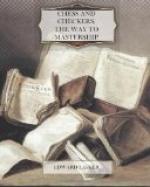In the following line of play it is assumed that Black makes the best moves, but the method employed is the same for any defensive maneuvers which Black might try, with the only difference that White would win still more quickly. (1) Kt-c5, B-c6; (2) B-f3, Bxf3; (3) Kxf3, P-b6; (4) Kt-e6, P-c5; (5) P-a4. This move retains the black Pawns so that the Knight can attack them with better effect. (5) ..., P-c4; (6) Kt-c7, K-g7; (7) Kt-b5, P-a6; (8) Kt-d6, K-f6; (9) Ktxc4, P-b5; (10) Pxb5, Pxb5; (n) Kt-a3, P-b4; (12) Kt-c2, P-b3; (13) Kt-d4, etc.
Often it happens that a player can give up his additional piece to advantage for one or two Pawns thereby enforcing an ending which is won on account of the Pawn position. Diagram 19 is an example.
+---------------------------------------+ 8 | | | | | | | | | |---------------------------------------| 7 | | | | | | | #P | | |---------------------------------------| 6 | | | | | #B | | | #K | |---------------------------------------| 5 | ^P | | | | | | | | |---------------------------------------| 4 | | ^Kt| | | | ^K | ^P | | |---------------------------------------| 3 | ^Kt| #P | | | | | | | |---------------------------------------| 2 | | | #P | | | | | | |---------------------------------------| 1 | | | | | | | | | +---------------------------------------+ a b c d e f g h
Diagram 19.
Black is a piece down but his two connected passed Pawns constitute a dangerous threat. White, therefore, does best to sacrifice a Knight for the two Pawns, as he then remains with two Pawns against one. Black must finally give up his Bishop for White’s a-Pawn who threatens to queen, and then White wins by capturing Black’s g-Pawn and queening his own. Play might proceed as follows: (1) Ktxc2, Pxc2; (2) Ktxc2, B-d5; (3) Kt-b4, B-a8; (4) P-a6, K-g6; (5) P-a7, K-f6; (6) Kt-a6, K-e7; (7) Kt-c7, B-h1; (8) P-a8 (Queen), Bxa8; (9) Ktxa8, K-f6; (10) Kt-c7, K-g6; (11) Kt-d5, K-h6; (12) K-f5, K-h7; (13) K-g5, K-h8; (14) K-g6, K-g8; (15) Kt-e7+, K-h8; (16) Kt-f5, K-g8; (17) Ktxg7, K-h8; (18) K-f7, K-h7; (19) P-g5, K-h8; (20) Kt-f5, White could not play P-g6, as Black would have been stalemate. (20) ..., K-h7; (21) P-g6+, K-h8; (22) P-g7+, K-h7; (23) P-g8 (Queen) mate.
The game endings discussed up to now have illustrated the method of winning with a superior force and it is now possible for the beginner to understand that the leading rule for all maneuvers is to avoid the loss of material—no matter how small—as it will ultimately lead to the loss of the game by one pawn or the other queening.




